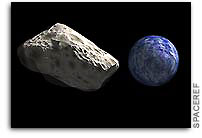All-Clear’ Asteroid Will Miss Earth in 2040

Using the Gemini North telescope on Mauna Kea, Hawaii, a team of astronomers from the University of Hawaii’s Institute for Astronomy (IfA) have confirmed that the chance of asteroid 2011 AG5 impacting Earth in 2040 is no longer a significant risk — prompting a collective sigh-of-relief. Previously, scientists estimated that the risk of this 140-meter-diameter (about the length of two American football fields) asteroid colliding with the Earth was as high as one in 500.
If this object were to collide with the Earth it would have released about 100 megatons of energy, several thousand times more powerful than the atomic bombs that ended World-War II. Statistically, a body of this size could impact the Earth on average every 10,000 years.
The observations, using the Gemini Multi-Object Spectrograph (and imager), were especially challenging said team-member Richard Wainscoat. “These were extremely difficult observations of a very faint object,” he said. “We were surprised by how easily the Gemini telescope was able to recover such a faint asteroid so low in the sky.” The Gemini observations were made on October 20, 21, and 27, 2012.
In addition to multiple observations since the asteroid’s discovery, the team had also acquired images about two weeks earlier with the University of Hawaii 2.2-meter telescope also on Mauna Kea — however, these data were all less conclusive and required confirmation. Gemini was able to make the follow-up observations rapidly due to the observatory’s scheduling flexibility and availability of several instruments at a moment’s notice.
IfA astronomers David Tholen, Richard Wainscoat, Marco Micheli, and Garrett Elliott conducted the original observations and analysis of the data. Further analysis was performed at NASA’s Near-Earth Object Program Office at the Jet Propulsion Laboratory (JPL) in Pasadena, California. The updated trajectory of 2011 AG5, based on the Gemini data, has a factor of 60 less uncertainty than the previous observations due in part to the increase in sampling points in the asteroid’s orbit. The original discovery was made from images obtained with the NASA-sponsored Catalina Sky Survey on Mt. Lemmon in Arizona.
According to a press release issued by JPL, while this new result has reduced the interest in 2011 AG5, the experience gained by studying this object and conducting a contingency deflection analysis has demonstrated that astronomers, using NSF and NASA facilities, are well poised to detect and predict the trajectories of Earth-threatening asteroids in the future.
The data for this study are being published by the Minor Planet Center in Cambridge, Massachusetts.
Media Contact:
Peter Michaud
Public Information and Outreach Manager
Gemini Observatory, Hilo, Hawaii
+1 (808) 974-2510, cell: +1 (808) 936-6643
pmichaud@gemini.edu
Science Contact:
David Tholen
Astronomer
University of Hawaii, Institute for Astronomy
+1 (808) 956-6930
tholen@ifa.hawaii.edu
The Gemini Observatory is an international collaboration with two identical 8-meter telescopes. The Frederick C. Gillett Gemini Telescope is located on Mauna Kea, Hawaii (Gemini North) and the other telescope on Cerro Pachon in central Chile (Gemini South); together the twin telescopes provide full coverage over both hemispheres of the sky. The telescopes incorporate technologies that allow large, relatively thin mirrors, under active control, to collect and focus both visible and infrared radiation from space.
The Gemini Observatory provides the astronomical communities in seven partner countries with state-of-the-art astronomical facilities that allocate observing time in proportion to each country’s contribution. In addition to financial support, each country also contributes significant scientific and technical resources. The national research agencies that form the Gemini partnership include: the U.S. National Science Foundation (NSF); the UK Science and Technology Facilities Council (STFC); the Canadian National Research Council (NRC); the Brazilian Ministerio da Ciencia, Tecnologia e Inovacao (MCTI); the Australian Research Council (ARC); the Argentinean Ministerio de Ciencia, Tecnologia e Innovacion Productiva; and the Chilean Comision Nacional de Investigacion Cientifica y Tecnologica (CONICYT). The Observatory is managed by the Association of Universities for Research in Astronomy, Inc. (AURA) under a cooperative agreement with the NSF. The NSF also serves as the executive agency for the international partnership.









